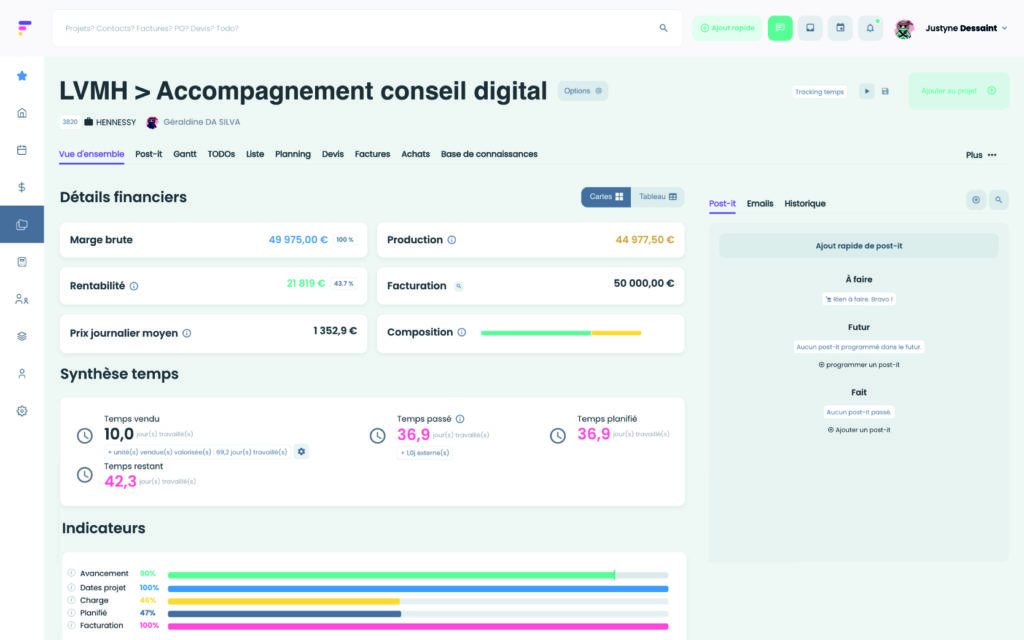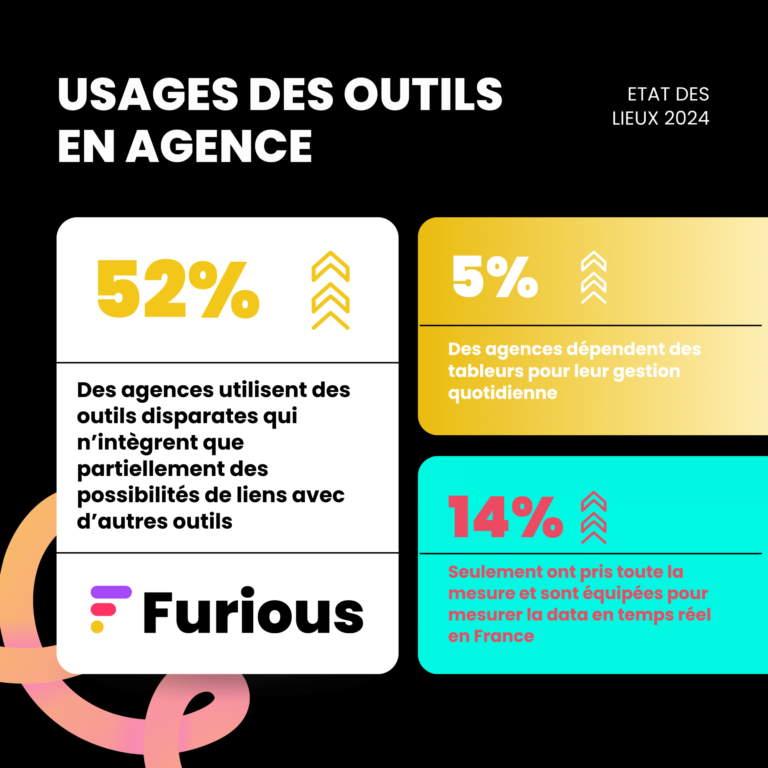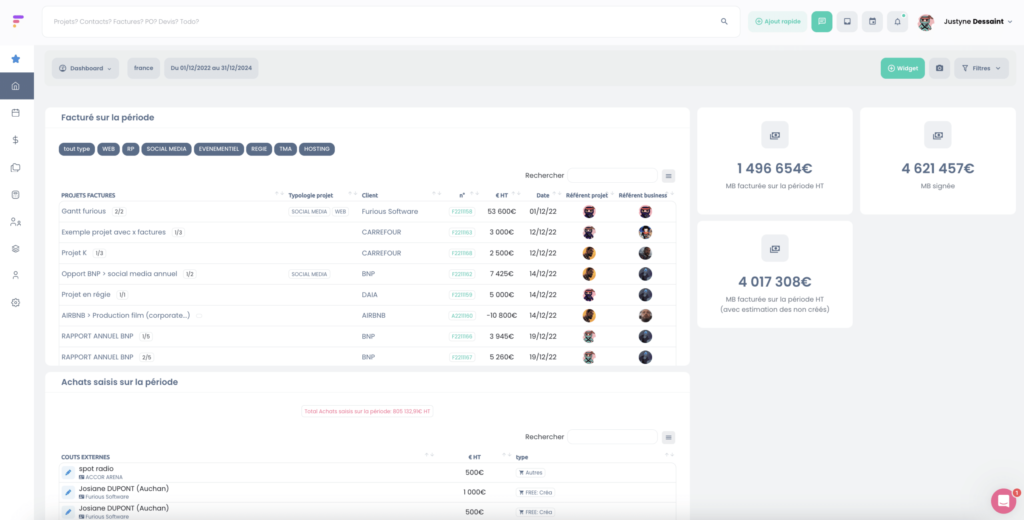A figure lives only because it is shared and enriched by all the players in the chain.
Matthieu Didailler, CFO d’Insign
This quote takes on its full meaning in the context of agencies, where financial management is more than just monitoring columns of figures. It’s a real balance between precision, anticipation and adaptation, where each player must play his part to avoid the pitfalls of imprecision.
And the stakes are high: only 36% of organizations manage to deliver their projects within budget, according to the Project Management Institute. A figure that highlights the complexity of project management and the importance of rigorous financial management.
Which projects are you losing money on?
As your agency grows, so does the workload. Financial teams, overwhelmed by repetitive tasks, find it hard to step back and focus on what really matters: profitability. How much time do your teams really devote to each project? Are your business units profitable? And are your individual occupancy rates optimized? These are all questions that deserve precise answers.
It’s no longer enough to note budget overruns after the fact. To secure your margins, you need strategic reflexes and the right tools to assess the profitability of your projects in real time.
In the ultra-competitive world of agencies, knowing which projects are making you lose money is essential. A deficit never happens by chance. Often, it’s the result of over-optimistic initial estimates, a poorly controlled project scope, or delays in deliverables that drive up costs. The question is not if, but when – and, above all, how to react before it’s too late.
Identify your loss-making projects now
The first step in reversing the trend is to be able to spot warning signs as early as possible. This means setting up a reliable system for monitoring key indicators. You need to monitor :
- Project progress: How is production progressing in relation to what has been sold?
- Actual time spent: How many hours have your teams already spent, by skill or business unit?
- Costs incurred: What are the direct costs (services, purchases) and indirect costs (internal expenses) associated with the project?
However, if you’re like most agencies, you probably have a problem with centralized information. Each team uses its own tools, often unconnected to each other. The result: retrieving the right data becomes a headache, and the exercise soon resembles that of a tightrope walker on a tightrope. The more scattered the information, the greater the risk of basing your decisions on erroneous or incomplete data.
What this means for you: Without immediate visibility of these indicators, it’s virtually impossible to effectively manage your profitability. To move forward with confidence, you need to be able to consult this data in real time and make informed decisions before the situation deteriorates.
Tools: allies or obstacles?
For finance teams, analyzing loss-making projects can quickly turn into a nightmare. Why is this? Because the tools used in-house are often under-utilized, poorly parameterized or, worse still, non-existent. Relying on outdated spreadsheets or scattered solutions can be costly.
Let’s take the example of an agency managing 20 simultaneous projects. If you spend several hours a week manually compiling time tracking, billing and costing data, not only are you wasting valuable time, but you’re also multiplying the risk of errors.
Ideally?
A centralized tool capable of :
- Automatically aggregate data from all your teams
- Display clear, up-to-date profitability indicators
- Issue alerts as soon as a project exceeds its break-even point

Why this step is essential
To ignore this phase is to accept that you’re navigating blindly. However, with the right reflexes, identifying your loss-making projects becomes a quick and efficient process. The earlier you intervene, the less the deficit will impact your margins.
Tip: Schedule weekly checkpoints on your high-risk projects. This will enable you to detect slippage before it becomes unmanageable.

- Above: view of budget metrics by project on Furious
Analysis and Diagnosis
Identifying loss-making projects is essential. But to correct the situation in the long term, it’s not enough to simply identify budget overruns: we need to understand the underlying causes. Why does a project exceed the initial budget? How can this be avoided in future projects? This analysis phase enables us to move from observation to action, by precisely targeting the points of failure.
Understanding the underlying causes
Behind a loss-making project often lies a combination of factors. Without an in-depth diagnosis, it’s difficult to implement appropriate solutions. Several sources of variance are frequently observed in agencies:
- Inadequate resource planning
- Over-optimistic or incomplete initial estimates
- Unclear management of the project scope, leading to unanticipated adjustments
- Accumulated delays generate additional costs
- Communication problems between internal teams and with customers
For every project with a deficit, it’s essential to document the discrepancies between forecasts and reality. Where are the biggest overruns? Is it unplanned time spent, over-budget purchases or underestimated expenses? This detailed understanding is essential to avoid making the same mistakes in the future.
Paul Vedrine, Management Control Officer - Jin Agency
The advantage of using multitasking software is the obvious connections between the different tasks. Using such software allows you to keep a broad financial scope in mind.
Turning analysis into concrete action
The aim of a diagnosis should not be limited to simple observation. It is a lever for rectifying the current situation and better preparing future projects. Once the causes have been identified, several actions can be envisaged:
- Reallocate resources to balance the workload
- Renegotiate deadlines or adjust deliverables with the customer if necessary
- Revise forecasts for the remaining phases of the project to limit damage
- Implement more rigorous validation processes for scope changes
This stage involves clear communication with your teams and customers. Being transparent about the adjustments required helps avoid misunderstandings and maintain trust, while fostering a collaborative working environment.
The importance of a reliable tool
Relevant analysis requires the right information. Many agencies, however, find it difficult to collect and process data. When tools are dispersed or poorly synchronized, teams spend a considerable amount of time manually cross-checking figures. This process is not only time-consuming, but also error-prone.
A centralized management tool gives you instant visibility of budget variances, hours consumed and margins associated with each project. Thanks to automated reports and configurable alerts, you’ll be able to react quickly. You can identify deviations as soon as they appear, rather than at the end of the project, when margins have already been impacted.
Adopting the right reflexes for the future
Diagnostics must become an integral part of your processes. Regular checks not only enable you to correct deviations on current projects, but also to capitalize on lessons learned for future assignments. Each analysis enriches your ability to anticipate, adjust your practices and boost the profitability of your projects.
Action Plan
Once the diagnosis has been made, it’s time to take action. Having accurate data on your loss-making projects is essential, but it’s no use if this information doesn’t lead to concrete decisions and corrective measures. Putting things right requires a clear plan, tailored to each project concerned.
Building an effective action plan
The action plan must be based on the lessons learned from the diagnosis, and respond to the causes identified. Several levers can be activated depending on the situation:
- Reallocate resources: adjust workloads to avoid overloading a team and optimize the use of available skills.
- Renegotiate deadlines or deliverables: whenever possible, discuss with the customer how to adjust the scope or push back certain deadlines in order to limit additional costs.
- Revising estimates: update your forecasts for the remaining phases of the project to avoid worsening the deficit.
- Strengthen internal controls: implement more rigorous processes to validate scope changes and better manage adjustments during the project.
Each action must be prioritized according to its impact on profitability and feasibility. An effective measure is one that can be implemented quickly without compromising the quality of the deliverable.
The importance of communication
Implementing an action plan requires fluid communication with all stakeholders. Internal teams need to understand the expected adjustments and the reasons behind them. On the customer side, transparency is essential. Clearly communicating any changes to deadlines or scope of work helps to avoid misunderstandings and maintain trust.
Organize regular meetings with your project and financial teams to monitor the progress of measures taken. If renegotiations with the customer are necessary, prepare arguments based on concrete data from your diagnosis.
Anticipate to avoid suffering
Although this plan is designed to correct current drifts, it should also serve as a basis for preventing the situation from recurring. Proactive management means integrating these actions into your standard processes. In future, this will enable you to detect weak signals earlier and take action before the situation deteriorates.

Adopting a long-term vision not only helps turn around projects in difficulty, but also strengthens your agency’s overall profitability in the long term.
Surgical action: anticipate budget overruns
Correcting a loss-making project is essential, but the real mastery of financial management lies in anticipation. Preventing budget overruns makes it possible to limit late corrective action and maintain project profitability without compromising customer relations or the quality of deliverables. This proactive approach, comparable to a surgical operation, requires precision, responsiveness and the right tools to intervene at the right time.
Agile, responsive budget management
Projects rarely go over budget without warning signs. These indicators are often visible long before the overrun materializes. But you need to be able to detect them. Rigid budget management, set only at the start of the project, limits responsiveness to unforeseen circumstances. Conversely, an agile approach enables forecasts, resources and expenditure to be adjusted on an ongoing basis.
Implementing agile budget management requires several key actions:
- Regularly update financial forecasts in line with actual project progress.
- Accurately track time spent to adjust planning according to discrepancies.
- Set up weekly checkpoints to anticipate work overloads or the need for additional resources.
- React quickly to changes in scope or delays to limit their financial impact.
This dynamic of continuous adaptation means that you won’t discover a budget overrun when the project has already been finalized, by which time it’s often too late to react.
Understanding profitability right from the pre-sales stage
Anticipation doesn’t begin with production. It begins at the quotation and negotiation stage. Over-optimistic pre-sales estimates lead to unrealistic budgets that teams struggle to meet. That’s why it’s crucial to take all costs into account from the outset: management time, possible revisions, unforeseen customer feedback and technical contingencies.
To do this:
- Analyze similar past projects to refine your estimates.
- Build in realistic safety margins to cover unforeseen events.
- Exchange with operational teams to validate the feasibility of proposed quotations.
Better upstream preparation limits any deviations that may occur along the way, and ensures smoother project management.

The importance of real-time monitoring
To adjust your budget management, you need to have a clear and instantaneous view of your key indicators. Waiting until project closure to take stock is a frequent and costly mistake. Real-time monitoring allows you to intervene as soon as deviations appear, and prevent them from worsening.
Modern management tools offer features such as :
- Automatic alerts when a project reaches certain consumption thresholds (50%, 75%, 90% of planned budget).
- Automatically updated dashboards with hours entered, costs incurred and project progress.
- Reports comparing initial forecasts with actual data to quickly identify discrepancies.
This responsiveness enables immediate corrective decisions to be taken, whether to reallocate resources, review the scope of the project or negotiate adjustments with the customer.
Capitalize on lessons learned for future projects
Jérôme Balmain, COO and co-founder - La Haute Société
Having a tool that covers the entire value chain, from centralization at the outset (quotation to pre-sales) to production and delivery of the device, enables us to be more consistent and better control our processes.
Anticipating budget overruns also means learning from past experience. Every completed project, whether profitable or not, holds valuable lessons. Regular reviews help to identify recurring patterns of overruns and adjust practices for future projects.
To optimize this process :
- Organize feedback meetings with the teams involved.
- Document the causes of deviations and the corrective actions taken.
- Update your estimating methodologies and internal processes.
By adopting this logic of continuous improvement, you strengthen your ability to anticipate slippage and secure the profitability of your projects.
Integration of Risk Management
Anticipating budget overruns requires rigorous risk management. Every project involves areas of uncertainty, whether in terms of scope variations, production delays or unforeseen costs. Ignoring these hazards exposes your projects to budget variances that are difficult to make up. Conversely, integrating risk management into your process enables you to identify potential failures before they affect profitability.
Identify risks upstream
The first step is to identify potential risks at the planning stage. A project can be affected by various types of risk:
- Operational: production delays, resource unavailability, technical errors
- Financial: underestimation of costs, price fluctuations of service providers or suppliers
- Organizational: communication problems, unexpected scope changes
- Contractual: poorly defined clauses can lead to additional costs
To leave nothing to chance, it’s essential to formalize a risk analysis at the start of the project. Gather feedback from operational teams, identify critical points in the schedule and list elements likely to generate additional costs.
Assessing probability and impact
Not all risks have the same level of severity. Once identified, it is necessary to classify them according to their probability of occurrence and their potential impact on budget and deadlines. This assessment enables us to prioritize the actions to be taken.
You can use a risk matrix to :
- Identify high-impact, high-probability threats requiring immediate action
- Prioritize risks that could have a significant impact on project profitability
- Identify minor risks requiring only regular monitoring
This approach avoids scattering efforts and allows resources to be concentrated on the most critical elements.

Set up response plans
Once the risks have been assessed, it’s time to define appropriate response plans. These plans can take several forms:
- Avoidance: modify the initial plan to eliminate the risk (e.g. choose a more reliable service provider, even if slightly more expensive).
- Mitigation: implement actions to limit the probability or impact of the risk (adjust deadlines, reinforce monitoring of deliverables).
- Transfer: outsource risk by subcontracting certain tasks or adjusting contractual clauses with the customer.
- Acceptance: assume the risk if it is deemed minor or if the solutions are too costly in relation to the expected benefits.
To be effective, each response plan must be assigned a manager and integrated into the day-to-day management of the project.
Tools for proactive monitoring
Risk management does not stop with risk identification. Ongoing monitoring is essential to detect any developments that could affect the project. Modern management tools offer specific functionalities:
- Automatic alerts triggered when certain budget thresholds are reached (50%, 75% or 90% of budget consumed)
- Risk reports updated in real time to anticipate slippage
- Collaborative platforms enabling each team member to report points of vigilance
Such monitoring enables decisions to be made on the basis of reliable data, without waiting for the project to exceed critical thresholds.
Integrate risk management into your agency culture
For this approach to be fully effective, it must become a reflex shared by all teams. Encourage your employees to report anomalies, organize regular reviews of risk trends, and align your internal processes with this preventive approach.
An agency that integrates risk management into its operational culture is better equipped to anticipate the unexpected, protect margins and boost customer satisfaction.
Use project budgeting from the outset and throughout the project
Budgeting is often seen as a formality to be carried out at the start of a project. However, to guarantee profitability, it needs to be a living process, adjusted throughout the project life cycle. By integrating it from the earliest stages and updating it regularly, you gain in responsiveness and accuracy. This proactive approach limits budget variances and facilitates informed decision-making.
Define a clear scope and precise objectives
Effective budgeting starts with defining the scope of the project. The more precise the scope, the more accurate the estimates. All too often, unclear objectives and deliverables lead to misunderstandings and unforeseen cost overruns.
To avoid these pitfalls:
- Draw up detailed specifications validated by all stakeholders
- Break the project down into sub-tasks with clear milestones
- Identify resource requirements for each stage of the project
- Prevent potential changes in scope by building in safety margins
A clear structure from the outset avoids costly adjustments along the way, and facilitates budget monitoring.
Choose the Appropriate Budgeting Methodology
Not all budgeting methods are created equal. The choice depends on the nature of the project, the complexity of the deliverables and the degree of flexibility required. There are three main approaches:
- Top-down budgeting: the overall budget is defined before being allocated to the various phases. This method is fast, but may lack precision if project details are not yet well established.
- Bottom-up budgeting: costs are estimated task by task before being consolidated. Longer to implement, this approach is ideal for complex projects requiring maximum precision.
- Value-based budgeting: the budget is adjusted according to the value generated at each stage. This model, often used in agile methods, allows greater flexibility and better adaptation to unforeseen circumstances.
Whatever the choice, the most important thing is to choose the method that offers the best balance between precision, flexibility and speed of execution.

Monitor and adjust throughout the project
Budgeting doesn’t stop when the quotation is approved. To be effective, it must be continually re-evaluated. Projects evolve: changes in scope, delays or resource adjustments can impact costs. Only regular budget updates can keep you on track.
To ensure this follow-up :
- Compare actual expenditure with initial forecasts at each key milestone
- Analyze discrepancies and identify the causes of overruns
- Adjust estimates for the remaining phases to limit future drift
- Communicate these adjustments to teams to ensure global alignment
A living, up-to-date budget offers a more realistic vision of the project, avoiding unpleasant surprises at the end of the assignment.
The contribution of budget management tools
Keeping track of a budget with scattered spreadsheets is a source of errors and wasted time. Today, centralized solutions can simplify this task while improving data reliability. A good budget management tool should offer :
- Real-time visualization of expenses incurred and updated forecasts
- Automatic alerts when budget thresholds are close to being reached
- The ability to integrate time spent, billing and purchasing data for a global view
- Detailed reports facilitate decision-making and communication with customers
By using these tools, you can react quickly and adjust your plans in just a few clicks, without waiting until the end of the project to react.
Promoting continuous improvement
Every project is a learning opportunity. By analyzing your past budgets and identifying areas for improvement, you strengthen your ability to estimate more accurately and better manage future projects.
To capitalize on these lessons :
- Organize end-of-project financial reviews with your teams
- Document significant deviations and the solutions implemented to remedy them
- Update your estimating methodologies to reflect this feedback
This continuous improvement process enables you to gain in precision and progressively optimize the profitability of your projects.
Optimize your profitability with Furious
The profitability of your projects depends not only on methods, but also on the right tools. In an environment where responsiveness and precision are essential, Furious is the all-in-one solution you need. Budget management, resource planning, time tracking and invoicing are all brought together on the same platform to streamline your processes.
Simplify your project management
Furious centralizes all your information, avoiding silos and losses. You benefit from a clear, global view to track your projects without friction. With Furious, you can :
- Create quotes for your projects
- Monitor your teams’ working hours and adjust your forecasts
- Manage billing without multiple tools
- Visualize your margins in real time
Promote collaboration and transparency
Smooth communication is the key to successful projects. Furious gives everyone involved access to the information they need: teams track their workloads, project managers monitor key indicators, and financial managers have access to up-to-date data. This transparency strengthens customer relations, thanks to accurate, easily-shared reports.
Make decisions based on reliable data
Furious transforms your data into actionable information via intuitive dashboards. Quickly spot risky projects, measure your performance and adjust your strategy with :
- Alerts on budget overruns and delays
- View margins by project or customer
- Comparisons between forecasts and actuals
- Analysis of occupancy rates to optimize resources
Choose a tool designed for agencies
Furious adapts to your needs, whether you run a small team or a large organization. Free up your administrative time and focus on what really matters: customer satisfaction and the growth of your agency.